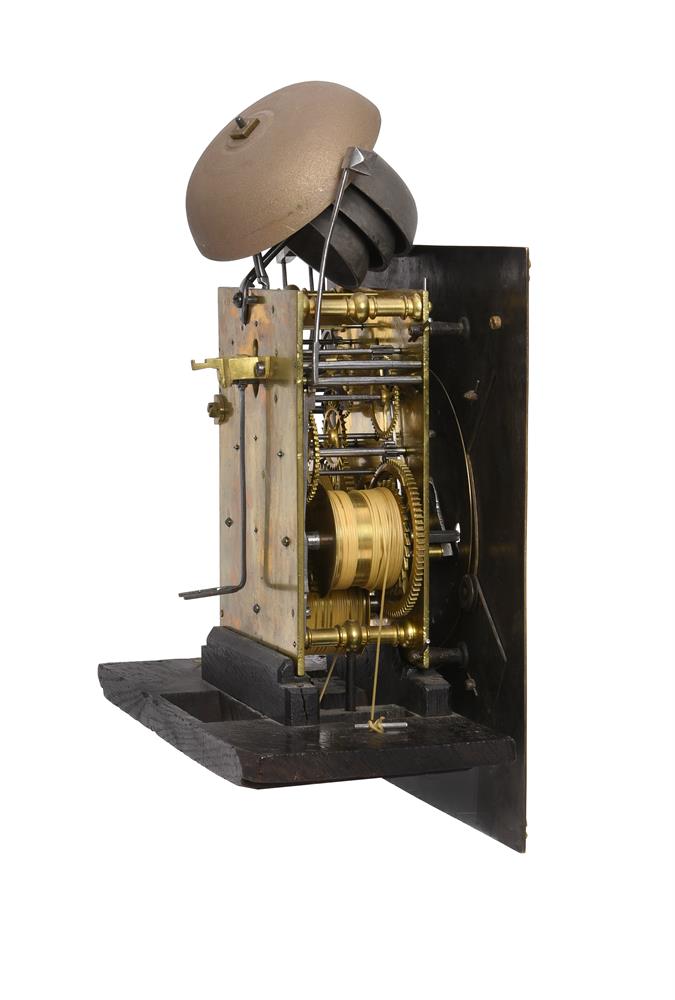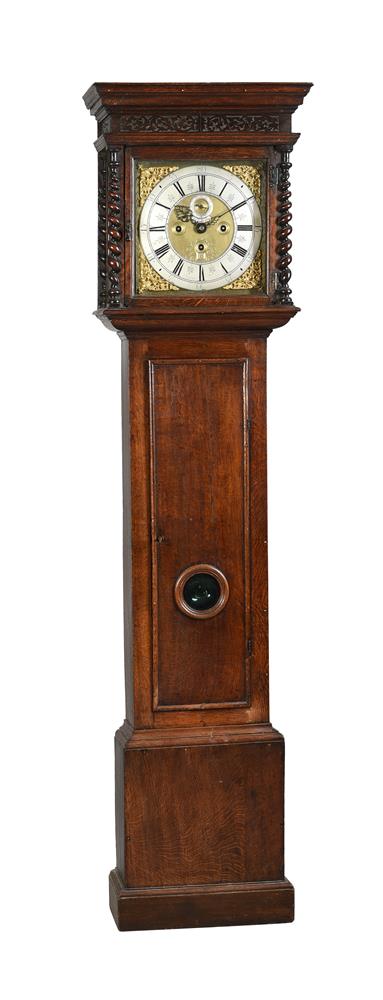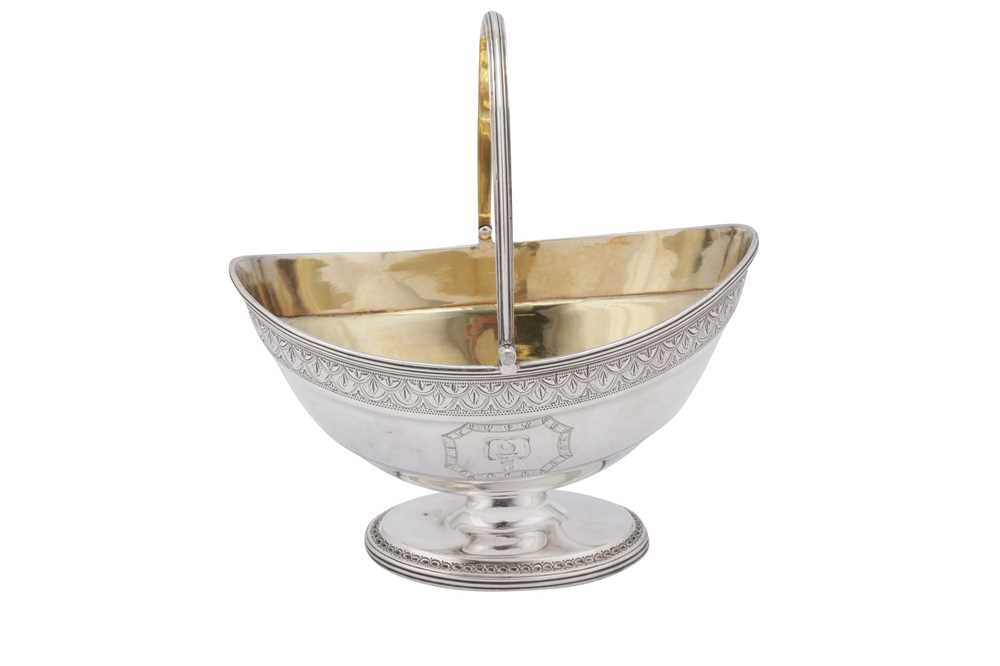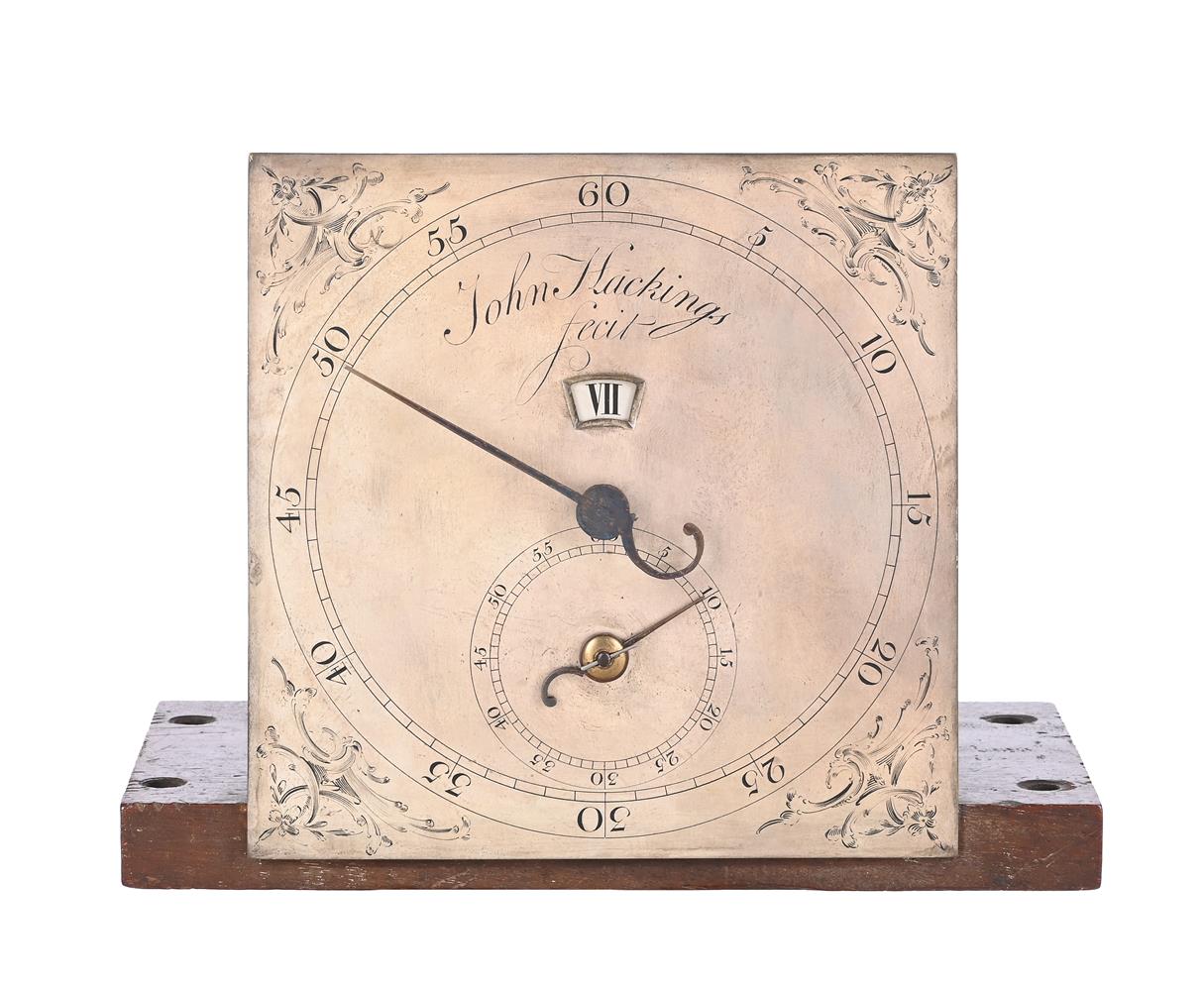AN INTERESTING WILLIAM III GRANDE-SONNERIE STRIKING AND REPEATING EBONISED 'BASKET TOP' TABLE CLOCK
ISAAC GODDARD, LONDON, CIRCA 1695
The six finned and latched pillar twin fusee bell striking movement with verge escapement regulated by short bob pendulum with knife-edge suspension, two-in one grande-sonnerie striking peeling the quarters on a graduated nest of three bells and sounding the hour on a further larger bell, and pull-quarter repeat operating on the same mechanism, the backplate engraved with symmetrical scrolling foliage including tulip blooms within a herringbone border around a central leafy cartouche signed Isaac Goddard, Londini, fecit, the upper right hand corner also incorporating steel lever for strike selection with three numbered positions, the 7.5 inch square brass dial with ringed winding holes and 'triple crown' border engraved calendar aperture to the matted centre within applied silvered Roman numeral chapter ring with stylised sword hilt half hour markers and small Arabic five minutes beyond the outer minute ring, with sculpted scroll-pierced steel hands, applied gilt winged cherub mask spandrels to angles and with S/N strike/silent selection switch at twelve o'clock, the case with Quare-type hinged foliate bud tied scroll-shaped carrying handle over pierced brass repousse 'basket' superstructure decorated with scrollwork inhabited by basket of flowers flanked by cornucopiae and cherubs to front and rear and pair of cherubs alone to each side, above rope twist and cast ogee moulded lower border, flanked by brass flambeau finials, with double-ogee top mouldings over hinged glazed front applied with foliate repousse mounts to the frame of the door incorporating a stretched lozenge sound fret to upper rail, the sides with conforming gilt lozenge frets over rectangular glazed apertures each overlaid with a relief foliate scroll decorated repousse panel incorporating laurel-bordered oval aperture to centre, the rear with glazed door set within the frame of the case, on conforming complex ogee moulded skirt base with gilt brass disc feet.
38cm (15ins) high with handle down, 27.5cm (10.75ins) wide, 18cm (7ins) deep.
Isaac Goddard is recorded in Loomes, Brian Clockmakers of Britain 1286-1700 as born circa 1661, apprenticed in 1675 to Thomas Grimes (through Samual Davis) and gaining his freedom of the Clockmakers' Company in 1684. He was married at St, Dunstan's in 1691 and is thought to have worked for the Stanton family of Clockmakers. Isaac Goddard signed the clockmakers oath of allegiance in 1697 and is thought to have worked in Holborn; Loomes further notes that he is not heard of after 1699.
The engraved 'triple crown' decoration around the calendar aperture of the current lot is a feature sometimes seen on longcase clocks dating from the 1690's and is generally thought to represent the unification of the three Kingdoms of England, Ireland and Scotland, which was first envisaged during the reign of James II in 1688 and was cemented by Act of Parliament in 1707. Indeed, it is possible that this decoration commemorates the signing of the clockmaker's oath of allegiance (to the crown) in 1697. The engraving to the backplate of the present timepiece can be also compared to decoration discussed in Dzik, Sunny ENGRAVING ON ENGLISH TABLE CLOCKS, Art on a Canvas of Brass within the chapter titled A CLOSER LOOK AT TULIP ENGRAVING pages 143-46. Indeed two backplates of closely related design (for clocks by William Speakman and Thomas Power) to that of the present lot are illustrated on page 145 (Figure 8.16).
The grande-sonnerie striking system within the present clock is a very unusual detail which utilises the fact that the pull-repeat system is powered directly by the fusee strike train rather than being driven by a supplementary spring barrel (or blade spring). In order to achieve this, the movement is fitted with a wheel within the motionwork applied with pins corresponding to each quarter, with the one at the half hour being slightly longer (than the first and third quarters), and the hour longer again. This wheel is set on a pump arbor with three positions governed by the lever on the backplate. The first pulls the pins clear of the repeat trip lever except for the hour, the hence clock only sounds the hours on the hour; the second moves the half hour into play, hence the clock sounds the hours along with its quarter at the half hour also; the third position provides full grande-sonnerie striking.
The underlying quarter-repeat system which allows this unusual striking system to be incorporated is devised with the quarter peel and hour hammer pins applied applied to the same pin barrel. When activated (tripped) the hammer assembly is first positioned to engage with the pins for the quarters, before the whole hammer block assembly is automatically shunted along in order for the offset hour hammer pin to operate the hour hammer. In addition to this, both the quarter and hour racks are neatly positioned one behind the other in order for the same gathering pallet to be used for both, with the hour rack hook lifted out of the way whilst the quarters are sounding. Two clocks (by Charles Gretton and John Adamson respectively) with closely related repeat systems to the present lot are described and illustrated in Dzik, Sunny BENEATH THE DIAL, English Clock Pull Repeat Striking 1675-1725 pages 486-89.
Naturally, as the entire striking system is powered by a single fusee train, the duration for which the 'grande-sonnerie' can be used between windings is limited. Indeed, with the third position set on the backplate (for full grande-sonnerie striking) the strike train will need to be wound approximately every two-and-a-half days.
AN INTERESTING WILLIAM III GRANDE-SONNERIE STRIKING AND REPEATING EBONISED 'BASKET TOP' TABLE CLOCK
ISAAC GODDARD, LONDON, CIRCA 1695
The six finned and latched pillar twin fusee bell striking movement with verge escapement regulated by short bob pendulum with knife-edge suspension, two-in one grande-sonnerie striking peeling the quarters on a graduated nest of three bells and sounding the hour on a further larger bell, and pull-quarter repeat operating on the same mechanism, the backplate engraved with symmetrical scrolling foliage including tulip blooms within a herringbone border around a central leafy cartouche signed Isaac Goddard, Londini, fecit, the upper right hand corner also incorporating steel lever for strike selection with three numbered positions, the 7.5 inch square brass dial with ringed winding holes and 'triple crown' border engraved calendar aperture to the matted centre within applied silvered Roman numeral chapter ring with stylised sword hilt half hour markers and small Arabic five minutes beyond the outer minute ring, with sculpted scroll-pierced steel hands, applied gilt winged cherub mask spandrels to angles and with S/N strike/silent selection switch at twelve o'clock, the case with Quare-type hinged foliate bud tied scroll-shaped carrying handle over pierced brass repousse 'basket' superstructure decorated with scrollwork inhabited by basket of flowers flanked by cornucopiae and cherubs to front and rear and pair of cherubs alone to each side, above rope twist and cast ogee moulded lower border, flanked by brass flambeau finials, with double-ogee top mouldings over hinged glazed front applied with foliate repousse mounts to the frame of the door incorporating a stretched lozenge sound fret to upper rail, the sides with conforming gilt lozenge frets over rectangular glazed apertures each overlaid with a relief foliate scroll decorated repousse panel incorporating laurel-bordered oval aperture to centre, the rear with glazed door set within the frame of the case, on conforming complex ogee moulded skirt base with gilt brass disc feet.
38cm (15ins) high with handle down, 27.5cm (10.75ins) wide, 18cm (7ins) deep.
Isaac Goddard is recorded in Loomes, Brian Clockmakers of Britain 1286-1700 as born circa 1661, apprenticed in 1675 to Thomas Grimes (through Samual Davis) and gaining his freedom of the Clockmakers' Company in 1684. He was married at St, Dunstan's in 1691 and is thought to have worked for the Stanton family of Clockmakers. Isaac Goddard signed the clockmakers oath of allegiance in 1697 and is thought to have worked in Holborn; Loomes further notes that he is not heard of after 1699.
The engraved 'triple crown' decoration around the calendar aperture of the current lot is a feature sometimes seen on longcase clocks dating from the 1690's and is generally thought to represent the unification of the three Kingdoms of England, Ireland and Scotland, which was first envisaged during the reign of James II in 1688 and was cemented by Act of Parliament in 1707. Indeed, it is possible that this decoration commemorates the signing of the clockmaker's oath of allegiance (to the crown) in 1697. The engraving to the backplate of the present timepiece can be also compared to decoration discussed in Dzik, Sunny ENGRAVING ON ENGLISH TABLE CLOCKS, Art on a Canvas of Brass within the chapter titled A CLOSER LOOK AT TULIP ENGRAVING pages 143-46. Indeed two backplates of closely related design (for clocks by William Speakman and Thomas Power) to that of the present lot are illustrated on page 145 (Figure 8.16).
The grande-sonnerie striking system within the present clock is a very unusual detail which utilises the fact that the pull-repeat system is powered directly by the fusee strike train rather than being driven by a supplementary spring barrel (or blade spring). In order to achieve this, the movement is fitted with a wheel within the motionwork applied with pins corresponding to each quarter, with the one at the half hour being slightly longer (than the first and third quarters), and the hour longer again. This wheel is set on a pump arbor with three positions governed by the lever on the backplate. The first pulls the pins clear of the repeat trip lever except for the hour, the hence clock only sounds the hours on the hour; the second moves the half hour into play, hence the clock sounds the hours along with its quarter at the half hour also; the third position provides full grande-sonnerie striking.
The underlying quarter-repeat system which allows this unusual striking system to be incorporated is devised with the quarter peel and hour hammer pins applied applied to the same pin barrel. When activated (tripped) the hammer assembly is first positioned to engage with the pins for the quarters, before the whole hammer block assembly is automatically shunted along in order for the offset hour hammer pin to operate the hour hammer. In addition to this, both the quarter and hour racks are neatly positioned one behind the other in order for the same gathering pallet to be used for both, with the hour rack hook lifted out of the way whilst the quarters are sounding. Two clocks (by Charles Gretton and John Adamson respectively) with closely related repeat systems to the present lot are described and illustrated in Dzik, Sunny BENEATH THE DIAL, English Clock Pull Repeat Striking 1675-1725 pages 486-89.
Naturally, as the entire striking system is powered by a single fusee train, the duration for which the 'grande-sonnerie' can be used between windings is limited. Indeed, with the third position set on the backplate (for full grande-sonnerie striking) the strike train will need to be wound approximately every two-and-a-half days.















Testen Sie LotSearch und seine Premium-Features 7 Tage - ohne Kosten!
Lassen Sie sich automatisch über neue Objekte in kommenden Auktionen benachrichtigen.
Suchauftrag anlegen